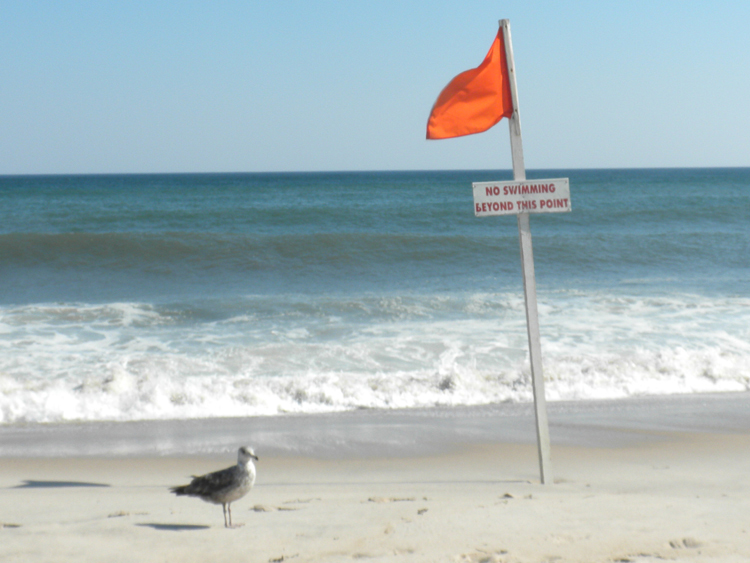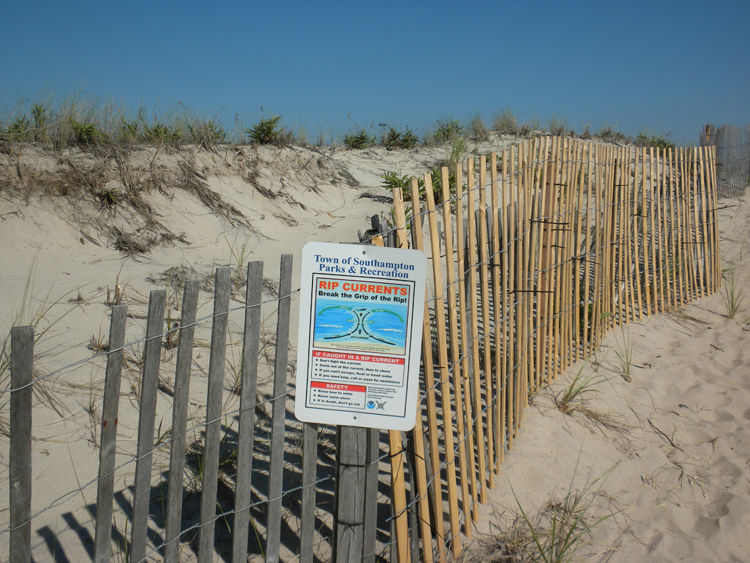Stony Brook, NY, August 28, 2012 - Just before the July 4th holiday weekend, New Jersey Sea Grant hosted a press conference in Asbury Park - which included remarks from the National Weather Service - to share information about activities and warning related to rip currents. These powerful currents of water moving away from shore are capable of sweeping even the strongest swimmers out to sea.
Each year the United States Lifesaving Association reports tens of thousands of rip current related rescues at beaches across the U.S. and an average 100 deaths. High rescue numbers can be linked to the fact that rip currents can be difficult to spot, especially when there are confused sea conditions.
This is why the National Oceanic and Atmospheric Administration and Sea Grant programs throughout the U.S. have long focused on educating the public via public forums, printed materials and Web sites about the dangers of rip currents.
The Sea Grant programs of the northeast mid-Atlantic (New York, New Jersey, and Delaware) are involved in several special projects aimed at increasing the public’s awareness of rip currents and other surf zone hazards. In New York, New York Sea Grant's (NYSG) Coastal Processes and Facilities Specialist Jay Tanski recently partnered with Stephen Leatherman, “Dr. Beach,” to distribute over 65,000 rip current awareness brochures in the Hamptons. Each year, these brochures are distributed by the Eastern Long Island Coastal Conservation Alliance and various partners, which have included NYSG as well as Stony Brook University (SBU) and SBU's School of Marine and Atmospheric Sciences, among others. This year's four-page color brochure is entitled "Understanding Waves and Currents" (pdf).
Knowledge of waves and currents can help beachgoers be safer at the beach. Big breaking waves that tower over five feet high are too dangerous for most bathers and swimmers, but even relatively small waves (e.g., 2-3 feet) that seem innocuous can generate dangerous rip currents.
Some of the "surf safety" checklist items outlined in this year's brochure are below. NYSG has an archive of brochures produced in previous years as well as additional rip current resources at www.nyseagrant.org/ripcurrents.
- Listen to the surf forecast
- Know your location in the event of an emergency; some beach accesses are numbered, while others are named by the road ending or landmarks.
- Look at the line of breakers for a few minutes for any tell-tale signs of rip currents; When in doubt, stay on the shore.
- Check for warning signs and flags; double red flags means the beach is closed, and a red flag indicates no swimming allowed.
- Swim near a lifeguard if possible
- In the event of a bather or swimmer in distress, call 911; do not attempt a rescue without a flotation device as many times the rescuer becomes another victim.
In addition to helping distribute rip current brochures, NYSG has also been an active supporter of research focused on improving understanding of rip currents. Most recently, the program supported a scholar who developed an integrated monitoring system using video beach cameras, wave observations and numeric models to better understand the conditions that cause rips on the south shore of Long island. The findings emphasized just how complicated rip currents can be to predict.
Rip currents are not only common in New York's marine, but also its Great Lakes waters. As cited in a recent clip from Minnesota Sea Grant, each year up to 30 people drown in the Great Lakes due to rip currents. In sharing the information in this clip, NYSG encourages New York's residents nearby Lakes Ontario and Erie to learn how to survive these currents before going to the beach. For more, see the video clip below or the related news item.

Beach warning flags come in a variety of colors, some of which are blank while others have symbols. The red, yellow, orange and green flags are warnings about the currents or surf. One or two red flags or a black flag means "high surf and no swimming," while green means "calm waters." Yellow signs report light surf or currents and advise caution.

Signs like this one at Ponquogue Beach in Hampton Bays, NY educate beach goers how to break the grip of a rip current if caught in one while swimming.